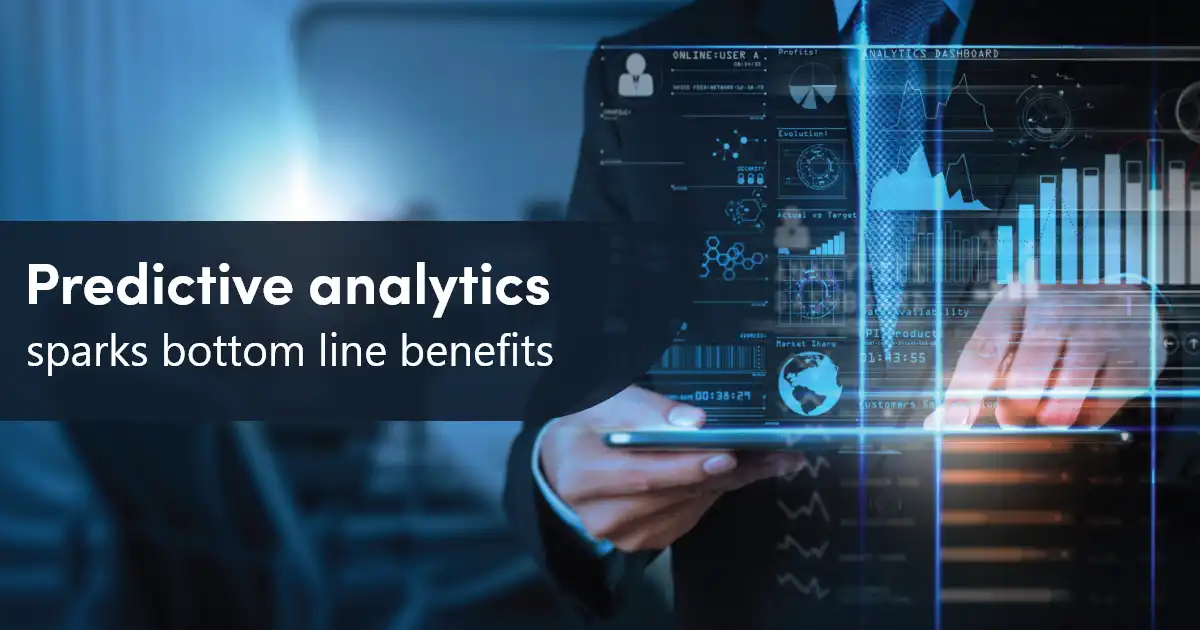Blog
How predictive analytics will improve your bottom line
28 Jun 2022

Enterprises are using analytics and artificial intelligence to transform their businesses with data insights.
With predictive analytics, you can increase the reach of your data insights, drive intelligent automation/machine learning, and employ predictive, personalized customer experiences. It will empower your employees to transform business solutions, increase control and visibility of your available data, ensure regulatory compliance, and improve performance.
What is Predictive Analytics?
As a branch of data science, predictive analytics uses historical data, statistical algorithms, predictive modeling, and “big data” machine learning techniques to help organizations predict future outcomes more accurately, plan for unknown events, and discover untapped opportunities. Its purpose is to help organizations make smarter, more informed decisions.
How Can Predictive Analytics Be Used in Business?
From healthcare to sports, businesses in all industries are seeing the value predictive analytics adds to their bottom line. Other benefits include:
- Understanding buying behaviors
- Meeting consumer expectations
- Shaping viewer experiences
- Finding new product and service opportunities
- Optimizing product performance
- Gaining a competitive edge
- Planning for anticipatory shipping
- Monitoring of suspicious financial activity
- Predicting future employee performance
- Reducing cost and risk
- Addressing problems before they happen
- Improving collaboration with employees and external partners
Many industries use predictive analysis as a core part of their strategy. Let’s look at some examples across different industries.
Predictive Analytics in Retail
Retail giants, Walmart and Amazon, are big fans of predictive analytics. Walmart acquired a California-based startup, Inkiru, to boost its big data capabilities and thereby provide a more personalized experience for its customers. This is done by accessing the vast data sources being captured and analyzed on the Inkiru platform.
In a similar vein, Amazon uses anticipatory shipping to plan for shipping products even before a customer has placed an order! If you are curious to learn more about how predictive analysis enhances customer experience, read more about its role in future forecasting.
Predictive Analytics in Insurance
Predictive analytics equips sales and marketing teams with a better understanding of customer segments and with the ability to offer customized insurance plans. The vast consumer data processed by machine learning also helps insurance companies launch new product offerings before their competitors do.
Predictive Analytics in Healthcare
According to a 2019 Predictive Analytics in Health Care Trend Forecast survey from the Society of Actuaries, 60 percent of healthcare executives say their organization has adopted predictive analytics. Predictive algorithms are helpful in tele-ICU settings. In those settings, patients are monitored remotely by critical care nurses and physicists. Since all the vital signs are being monitored, tracked, and analyzed, a predictive algorithm can (and is being) used to help healthcare staff identify the highest probability of patients requiring medical intervention within one hour. As such, it enables caregivers to proactively check on their patient’s conditions to make quick medical decisions.
Predictive Analytics in Manufacturing
Some of the greatest challenges for manufacturers include operations optimization, cost savings, production quality improvement, and demand forecasting. The good news is that predictive analysis in manufacturing addresses all four challenges.
It enables manufacturing organizations to store their vast and complex data in one place. This centralized data system acts as a single source of truth for accurate and consistent data. Then, based on a company’s business goals, the choices and actions to realize these goals can be accounted for using predictive analytics. For example, predictive maintenance analyzes the aggregate data from real-time sensors on parts, components, or machines to more accurately estimate:
- When downtime is likely to happen
- When machine parts need replacing
- The probability of equipment failure during high-volume periods
- The likely cause of failure
- Which equipment shows the highest short-term risk in terms of qualitative, quantitative, or financial risks
Predictive Analytics in Finance
The finance department traditionally relied on a set of historical sales data, stored on excel sheets and other manual reporting processes, to determine minimum production/services requirements. This process is time-consuming and filled with data inaccuracies due to data silos. There is a pressing need for the finance team to turbocharge their cash forecasting capabilities, demand planning, and company performance risk management. With such predictive analysis, finance executives can leverage data insights from a centralized repository and identify the trends to identify slow payers, identify small segment customers with high revenue and expose hidden risks.
Predictive Analytics in Sales and Marketing
Predictive sales analytics forecasting is only as useful as the information it is drawn from. If the historical data is inaccurate, the predictive sales analytics from it will be inaccurate as well. This is true for any function within an organization.
In the case of sales, with accurate and consistent data flowing into your system, predictive analytics enables your sales team to identify trends from interactions with previous leads and offer special discounts based on slicing and dicing your buyer persona behavior and buying trends. Similarly, in the case of marketing, it provides marketers with data insights from a centralized data collection system on market trends, online and offline engagements with digital assets. This helps them to fine-tune their marketing firepower and move leads down the sales funnel to ultimately convert.
Connect more closely with your customers, anticipate behaviors and proactively act upon possible risks or opportunities ultimately impacting your bottom line. Predictive analytics helps you do all of that.
Alphavima's expertise in Microsoft Data Analytics helps you to drive success in your journey with data and analytics for the present and future. We make sure to provide accurate, real-time data with easy access to further automate and optimize to steer your business forward.
